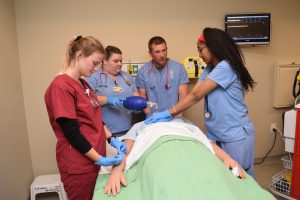
When Salisbury University’s Richard A. Henson Medical Simulation center opened in 2011, it had one robotic child patient, “Chuckie.” An early generation high-fidelity manikin, he wasn’t very life-like and lacked some functionality.
“But, in a very short time, our simulator family grew,” said Dr. Lisa Seldomridge, director of graduate and second degree nursing programs. “Now we have a brand new child manikin, a high-end adult manikin, a birthing manikin and two newborn manikins! All are wireless and tetherless, and much easier to use.”
The Sim Center also expanded its physical space by more than a third with a recent renovation. SU now has some 7,500 square feet to provide high-quality clinical simulation and training for students across health care fields, as well as community professionals.
“Our new addition includes a high-tech debriefing space and classroom, which allows us to accommodate more learners,” Seldomridge said.
The Sim Center is designed to be a “safe space” for students to practice, make mistakes and master new skills as they learn how to think like health professionals, including nurses and respiratory therapists. “The equipment and supplies that we have to replicate the clinical environment are extraordinary,” Seldomridge added.
Dr. Robert Joyner, respiratory therapy program director and associate dean of the Richard A. Henson School of Science and Technology, said interprofessional learning opportunities are another unique feature that have expanded.
“Students from different professions are able to interact side-by-side and on teams because that is how they are going to practice in the real world,” he said.
The center is used for research by SU applied health physiology graduate students and faculty. It also has been used by the University of Maryland Eastern Shore’s Doctor of Physical Therapy program, as well as SU mathematics students.
Community groups that have trained there include Peninsula Regional Medical Center (PRMC) pediatric hospitalists, area school nurses, the Wicomico County Health Department’s Drug Action Response Team and the Eastern Shore Collaborative for Interprofessional Education of Health Care Professionals. Other users include Bay Shore Services, Worcester Technical High School, Leadership Maryland, the SU Women’s Circle, Girl Scouts of the Chesapeake Bay, Eastern Shore legislators and Delaware Technical Community College’s Upward Bound program.
In addition, the Sim Center houses SU’s Eastern Shore Faculty Academy and Mentoring Initiative (ES-FAMI), a grant-funded educational program for clinical nurses who want to teach at Salisbury or regional community colleges. New built-in video conferencing technology better links the academy to regional partners, including Chesapeake College and Shore Regional Health System.
Simulation coordinator Deanna Schloemer said SU students use four specialized labs for neonatal, pediatric and adult care, and labor and delivery. They make real-time decisions about injuries, diseases and births. A mental health wing features “standardized patients” or trained actors who also have roles in some manikin simulations. Everything is video recorded for later review with professors.
“Students feel much better prepared for real clinical settings,” Seldomridge said. “There’s a lot of personal attention, feedback and coaching from faculty.”
Alumnus Jeff Geary ’17, now employed as a respiratory therapist at PRMC, said: “Not everything you are expected to do as a clinical practitioner can be learned through a textbook. It takes hands on experience. Doing it on a manikin makes it easier. It’s not just knowledge, it’s something you can actually perform.”
Located near campus at 106 Pine Bluff Road, the Sim Center and its offerings have been supported by over $3.7 million in grants from the Maryland Hospital Association and the Maryland Higher Education Commission NSP-2 program; a $1 million gift from the Richard A. Henson Foundation, Inc.; and funding and space provided by the SU Foundation, Inc. and Henson School. Delmarva Veteran Builders led the expansion.
For more information visit, www.salisbury.edu/henson/simcenter.
/eof
Pictured: Salisbury University nursing and respiratory therapy students work together inside SU’s Richard A. Henson Medical Simulation Center.



